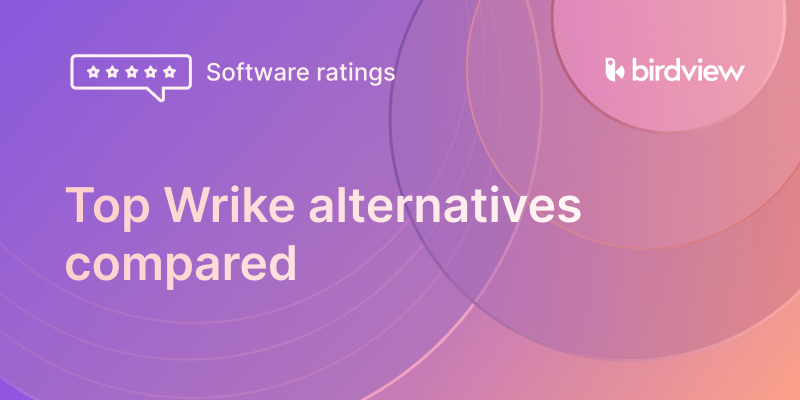Managing lots of projects at the same time is hard. Teams often have too much on their plate, not enough time or people, and no clear way to decide what should come first. Without a good system in place, projects can end up competing for attention, moving in different directions, or missing their goals entirely. That‘s where project portfolio management (PPM) helps.
It gives you a clear view of all your active work, so you can focus on the right projects, use resources wisely, and adapt when things change. Instead of looking at each project on its own, PPM helps you see the big picture–and make better decisions because of it. In this guide, we‘ll walk through the key benefits of project portfolio management–especially for service firms–along with practical tips and real-world examples.
In this article
7 top benefits of project portfolio management
1. Align projects with business strategy
The challenge: It‘s common for teams to take on projects that don‘t clearly contribute to business goals. Over time, this leads to scattered efforts and diluted impact.
Where PPM makes a difference: Portfolio management gives decision-makers a clear view of which initiatives truly support strategic priorities. You can evaluate proposals based on ROI, relevance, and timing–so only the right projects move forward.
Example: A digital agency evaluates 15 upcoming projects and discovers several low-margin ones misaligned with their new enterprise-focused strategy. With PPM, they decline those in favor of high-impact work that fits their vision.
💡 Tip: Start with a formal intake and scoring process to evaluate alignment early. Even a simple priority matrix can help guide smarter decisions.
2. Maximize resource utilization
The challenge: When teams are overloaded or underused, productivity suffers–and so does morale. Without visibility, it‘s hard to see who‘s stretched too thin or sitting idle.
A smarter approach: Portfolio-level planning allows you to balance workloads, assign the right people based on skills and availability, and avoid conflicts before they happen.
Example: A consulting firm notices their lead data engineer is overbooked, while junior staff have room to contribute. By redistributing assignments using Birdview PSA‘s Workload view, they avoid burnout and speed up delivery. In data-focused teams, where data scientists handle different tasks, clear workload visibility helps keep work efficient and supports learning.
💡 Tip: Review resource availability weekly. Look at both hours and skill alignment–especially for high-demand roles.
3. Reduce project risks across the board
The challenge: Most risk management happens at the individual project level, which means broader patterns and bottlenecks often go unnoticed until it‘s too late.
The portfolio perspective: With PPM, you can identify shared risks–like overdependence on key roles, unrealistic timelines, or technology constraints–that span multiple projects. This helps you plan ahead and avoid costly surprises.
Example: An engineering firm finds that several high-stakes projects all rely on one senior architect. They adjust the schedule and bring in external support to minimize delivery risk.
💡 Tip: Maintain a centralized RAID log (Risks, Assumptions, Issues, Dependencies) across your portfolio. This makes it easier to spot systemic issues.
4. Enable better, faster decisions
The challenge: Without up-to-date insights, teams often rely on guesswork when deciding what to prioritize or cut. That‘s risky in fast-moving environments.
The benefit: Real-time dashboards and reports help you track project performance, resource use, and financials all in one place. With the full picture, leadership can respond quickly when priorities shift.
Example: A service provider sees that one major project is draining resources but delivering low ROI. They pause it and reassign the team to a more strategic client account.
💡 Tip: Create a short list of portfolio KPIs–like budget variance, project margin, and team utilization–and review them regularly. Don‘t wait for quarterly reports.
5. Increase transparency and accountability
The challenge: When there‘s limited visibility into what‘s going on, confusion and blame tend to follow. Stakeholders may feel out of the loop or unsure about progress.
The solution: A portfolio-level view keeps everyone on the same page. Executives get clarity on strategic direction, project managers stay informed, and teams know how their work fits into the bigger picture.
Example: A marketing agency uses a shared dashboard to show executives which campaigns are active, behind schedule, or pending approval. This reduces check-in meetings and builds trust.
💡 Tip: Use visual tools like Gantt charts, Kanban boards, or project calendars to keep stakeholders informed. In Birdview PSA, dashboards can be customized by role so everyone sees what matters most to them.
6. Stay agile when priorities shift
The challenge: In dynamic industries, project priorities can change overnight. Without control at the portfolio level, adapting can be messy and disruptive.
The strategic edge: PPM helps you adjust course quickly–pausing less critical work, reallocating resources, or fast-tracking high-impact projects without derailing everything else.
Example: A managed IT firm experiences a sudden spike in security-related client requests. Thanks to PPM visibility, they pause internal development work and redirect talent toward urgent, revenue-driving engagements.
💡 Tip: Build flexibility into your project roadmap. Label some initiatives as stretch or optional to make room for last-minute changes.
7. Improve financial performance
The challenge: When you manage projects in isolation, it’s hard to see where money is being lost–or where profit potential is hiding.
The financial upside: PPM gives you tools to compare forecasts to actuals, track margins, and optimize where your money and effort go. You can prioritize high-value work and stop budget drain before it spreads.
Example: A consulting firm uses Birdview PSA to track project profitability by client segment. They learn that midsize tech clients are twice as profitable as enterprise contracts, so they shift sales and delivery focus accordingly.
💡 Tip: Monitor both direct costs and opportunity costs. Sometimes the most expensive project isn‘t the one over budget–it‘s the one that blocks more valuable work.
Project portfolio management isn’t just for large enterprises. Any team juggling multiple projects can benefit from a more strategic, top-down view of their work.
From aligning with business goals to making better use of your people and budget, PPM provides the clarity, structure, and insight you need to succeed in today‘s fast-paced environment.
Whether you use spreadsheets or platforms like Birdview PSA, what matters most is adopting a portfolio mindset–one that sees the bigger picture and helps you deliver the right work, at the right time, with the right resources.
Challenges and limitations of project portfolio management
While project portfolio management (PPM) offers many advantages, it‘s not without its challenges–especially during early adoption. Like any strategic approach, it requires time, effort, and organizational alignment to work effectively. Here are some of the common limitations and how to manage them.
1. It requires a cultural shift
The issue: Implementing PPM means moving from a project-by-project mindset to a portfolio-wide perspective. This often demands more coordination, transparency, and long-term thinking–which not everyone is ready for.
What it looks like in practice: Project managers may feel like they‘re losing autonomy. Department leads may resist when their priorities are overruled by portfolio-level decisions.
💡 Tip: Start small. Choose a pilot portfolio or department to introduce the process, and showcase early wins to build buy-in. Communicate how PPM supports–not replaces–team-level decision-making.
2. It can be resource- and time-intensive to set up
The issue: Getting a PPM system up and running takes effort. You‘ll need to define processes, train staff, and centralize data from multiple projects and tools.
What it looks like in practice: Early on, teams may feel overwhelmed by new forms, reports, or approval workflows. Leadership might be frustrated by the time it takes to see results.
💡 Tip: Don‘t overengineer from day one. Focus on the core elements–intake, prioritization, resource planning–and build from there. If using a PSA tool like Birdview, start with basic dashboards and templates before rolling out advanced features.
3. Data quality and consistency are critical
The issue: PPM decisions are only as good as the data behind them. Incomplete, outdated, or inconsistent data across projects can lead to poor prioritization or misallocation of resources.
What it looks like in practice: Forecasts that don‘t match reality, overloaded teams, or missed deadlines–despite “green” status in reports.
💡 Tip: Standardize how project data is reported and reviewed. Automate data collection where possible (Birdview PSA, for example, syncs time tracking, expenses, and progress updates), and assign owners to keep portfolio-level data clean.
4. It may feel too rigid for creative or fast-paced teams
The issue: Some teams, especially in creative or startup environments, may feel that PPM slows them down. The structured approvals, prioritization gates, or performance tracking may clash with their agile way of working.
What it looks like in practice: Teams bypass the process to “just get things done,” or they disengage entirely because they see PPM as red tape.
💡 Tip: Make your PPM process adaptable. Hybrid models work well–allowing teams to operate with flexibility while still reporting key milestones and resource needs at the portfolio level.
5. Too much focus on efficiency can overshadow innovation
The issue: PPM often emphasizes ROI, timelines, and resource utilization. While that‘s important, it can lead to undervaluing exploratory or experimental projects that don‘t have immediate payoff.
What it looks like in practice: Riskier or innovative projects get deprioritized in favor of safer, faster-to-deliver work–potentially limiting long-term growth.
💡 Tip: Make space for innovation in your portfolio. Consider setting aside budget and capacity for R&D or experimentation, and measure success differently for these types of projects.
Project portfolio management offers powerful advantages, but it‘s not a silver bullet. It takes planning, discipline, and continuous refinement. The good news? Most of its challenges can be addressed with the right mindset and tools.
Start small, stay flexible, and focus on outcomes–not just process. Over time, the structure PPM provides can become a valuable asset, not a burden–giving your organization the clarity and control it needs to scale wisely.
Quick glance: is project portfolio management right for you?
Project portfolio management isn‘t perfect–but it‘s powerful. To help you weigh the trade-offs, here‘s a quick reference guide highlighting the main pros and cons of adopting PPM in your organization.
| ✅ Key benefits | ⚠️ Common challenges |
|---|---|
| Strategic alignment – Ensures all projects support business goals | Initial setup effort – Time-consuming to centralize processes and data |
| Smarter resource use – Helps avoid overbooking or underutilizing teams | Cultural resistance – Teams may struggle with new structure or oversight |
| Risk visibility – Spot cross-project issues before they escalate | Data dependence – Poor inputs lead to poor portfolio decisions |
| Data-driven decisions – Make calls based on performance, not guesswork | Potential rigidity – May feel restrictive to fast-moving teams |
| Better forecasting – Improve budget accuracy and long-term planning | Requires ongoing discipline – Dashboards and reports don‘t run themselves |
| Stakeholder clarity – Everyone sees what matters and why | – |
Why service firms need project portfolio management
Service firms–like consultants, engineers, and IT providers–handle a lot of projects at once. Their teams are often working across multiple client projects, managing tight deadlines, and adapting to shifting priorities. When things aren‘t well organized, even small problems–like double-booked staff or unclear priorities–can slow everything down or cause projects to go off track.
Project portfolio management (PPM) helps bring order to the chaos. It gives firms one place to plan, track, and prioritize all their work. Leaders can quickly see what‘s coming up, where the risks are, and whether current projects are helping move the business forward. With PPM, it‘s easier to stay focused, deliver on time, and use your team‘s time and energy where it really counts.
Final thoughts: The real value of PPM
Project portfolio management isn‘t just a tool–it‘s a mindset. When applied thoughtfully, it brings order to chaos, connects project work to business strategy, and empowers your teams to deliver higher value with fewer missteps.
While implementing PPM takes effort, the payoff is clear: better decisions, happier teams, and stronger business outcomes. Whether you use software like Birdview PSA or start with a simple spreadsheet, the key is to start thinking beyond individual projects–and start managing the bigger picture.
Want to see Birdview PSA in action? Book a personalized walkthrough or start your free trial today.
Or
You may be interested in…
What Is PSA Software? Full Guide For Service Firms
PMO Services in Professional Services Firms – The Ultimate Guide
Professional Services Resource Management – Ultimate Guide
Benefits of Professional Services Automation Software
FAQ: Project Portfolio Management
1. What is project portfolio management?
It‘s a strategic process that helps organizations evaluate, prioritize, and manage multiple projects as a unified portfolio. The goal is to ensure projects align with business objectives and make the best use of resources.
2. Who typically uses PPM?
PPM is used by executives, PMOs, project managers, and resource planners in industries like consulting, IT services, engineering, and marketing–anywhere teams juggle multiple projects.
3. Is project portfolio management only for large enterprises?
No. While large companies often use advanced PPM software, small and midsize businesses can apply PPM principles using lighter tools like spreadsheets or integrated platforms such as Birdview PSA.
4. What tools are used for PPM?
Popular tools include PSA platforms (e.g., Birdview PSA), project management software with portfolio views (e.g., Wrike, Asana), and BI dashboards. The key is centralized visibility.
5. How long does it take to see results?
That depends on your maturity level and tools. With basic intake, prioritization, and reporting in place, many teams see improvements within 1–2 months–especially in resource clarity and decision-making.



